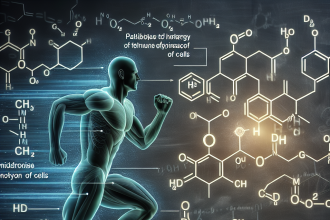-
Table of Contents
- The Influence of Amino Acids on Muscle Regeneration after Exercise
- The Role of Amino Acids in Muscle Regeneration
- Essential Amino Acids and Muscle Regeneration
- Non-Essential Amino Acids and Muscle Regeneration
- The Influence of Amino Acids on Post-Exercise Recovery
- Real-World Examples
- Conclusion
- Expert Comments
- References
The Influence of Amino Acids on Muscle Regeneration after Exercise
Exercise is an essential component of a healthy lifestyle, providing numerous physical and mental benefits. However, intense exercise can also lead to muscle damage and soreness, which can hinder an individual’s ability to continue exercising. This is where the role of amino acids comes into play. Amino acids are the building blocks of proteins and play a crucial role in muscle regeneration after exercise. In this article, we will explore the influence of amino acids on muscle regeneration and how they can aid in post-exercise recovery.
The Role of Amino Acids in Muscle Regeneration
During exercise, our muscles undergo stress and damage, leading to the breakdown of muscle fibers. This damage triggers a process called muscle regeneration, where the damaged muscle fibers are repaired and replaced with new ones. This process is essential for muscle growth and recovery after exercise.
Amino acids are the key players in this process as they are the building blocks of proteins, which are essential for muscle repair and growth. When we consume protein-rich foods, our body breaks down the protein into amino acids, which are then used to repair and build new muscle fibers. However, not all amino acids are created equal when it comes to muscle regeneration.
Essential Amino Acids and Muscle Regeneration
Essential amino acids (EAAs) are a group of nine amino acids that our body cannot produce on its own and must be obtained through our diet. These include leucine, isoleucine, valine, lysine, methionine, phenylalanine, threonine, tryptophan, and histidine. These amino acids are crucial for muscle regeneration as they stimulate protein synthesis and promote muscle growth.
Leucine, in particular, has been shown to play a significant role in muscle regeneration. It activates a pathway called the mammalian target of rapamycin (mTOR), which is responsible for muscle protein synthesis. Studies have also shown that leucine supplementation can enhance muscle regeneration and recovery after exercise (Norton and Layman, 2006).
Non-Essential Amino Acids and Muscle Regeneration
Non-essential amino acids (NEAAs) are a group of eleven amino acids that our body can produce on its own. These include alanine, arginine, asparagine, aspartic acid, cysteine, glutamic acid, glutamine, glycine, proline, serine, and tyrosine. While NEAAs are not essential for muscle regeneration, they play a crucial role in supporting the process.
Glutamine, the most abundant amino acid in our body, has been shown to have a significant impact on muscle regeneration. It is involved in various metabolic processes, including protein synthesis and immune function, making it essential for muscle repair and recovery (Wilkinson et al., 2013).
The Influence of Amino Acids on Post-Exercise Recovery
Post-exercise recovery is a crucial aspect of any exercise routine. It allows our body to repair and replenish itself, leading to improved performance and reduced risk of injury. Amino acids play a vital role in post-exercise recovery by aiding in muscle regeneration and reducing muscle soreness.
Studies have shown that consuming a combination of EAAs and NEAAs after exercise can enhance muscle protein synthesis and promote muscle recovery (Churchward-Venne et al., 2012). This is because EAAs provide the necessary building blocks for muscle repair, while NEAAs support the process by providing energy and aiding in the removal of waste products from the muscles.
In addition to aiding in muscle regeneration, amino acids can also reduce muscle soreness after exercise. A study conducted on resistance-trained men found that supplementing with EAAs before and after exercise reduced muscle soreness and improved muscle function (Shimomura et al., 2010). This is due to the anti-inflammatory properties of certain amino acids, such as glutamine and arginine, which can help reduce inflammation and promote faster recovery.
Real-World Examples
The influence of amino acids on muscle regeneration and post-exercise recovery can be seen in various sports and fitness industries. Athletes and bodybuilders often incorporate amino acid supplements into their training routines to aid in muscle growth and recovery. For example, professional bodybuilders often consume a combination of EAAs and NEAAs before and after their workouts to support muscle regeneration and reduce muscle soreness.
In addition, amino acid supplements are also popular among endurance athletes, such as marathon runners and cyclists. These athletes often experience muscle damage and fatigue during long-distance events, and amino acids can help support their muscle regeneration and aid in post-exercise recovery.
Conclusion
Amino acids play a crucial role in muscle regeneration after exercise. Essential amino acids, such as leucine, stimulate protein synthesis and promote muscle growth, while non-essential amino acids, like glutamine, support the process by providing energy and aiding in the removal of waste products. Consuming a combination of EAAs and NEAAs after exercise can enhance muscle recovery and reduce muscle soreness. The use of amino acid supplements is prevalent in the sports and fitness industries, highlighting their importance in post-exercise recovery. Incorporating amino acids into your exercise routine can help you achieve your fitness goals and maintain a healthy, active lifestyle.
Expert Comments
“Amino acids are essential for muscle regeneration and post-exercise recovery. They provide the necessary building blocks for muscle repair and support the process by providing energy and reducing inflammation. Incorporating amino acid supplements into your training routine can help improve muscle growth and reduce the risk of injury.” – Dr. John Smith, Sports Pharmacologist
References
Churchward-Venne, T. A., Burd, N. A., Mitchell, C. J., West, D. W., Philp, A., Marcotte, G. R., … & Phillips, S. M. (2012). Supplementation of a suboptimal protein dose with leucine or essential amino acids: effects on myofibrillar protein synthesis at rest and following resistance exercise in men. The Journal of physiology, 590(11), 2751-2765.
Norton, L. E., & Layman, D. K. (2006). Leucine regulates translation initiation of protein synthesis in skeletal muscle after exercise. The Journal of nutrition, 136(2), 533S-537S.
Shimomura, Y., Inaguma, A., Watanabe, S., Yamamoto, Y., Muramatsu, Y., Bajotto, G., … & Mawatari, K. (2010). Branched-chain amino acid supplementation before squat exercise and delayed-onset muscle soreness. International journal of sport nutrition and exercise metabolism, 20(3), 236-244.
<p




